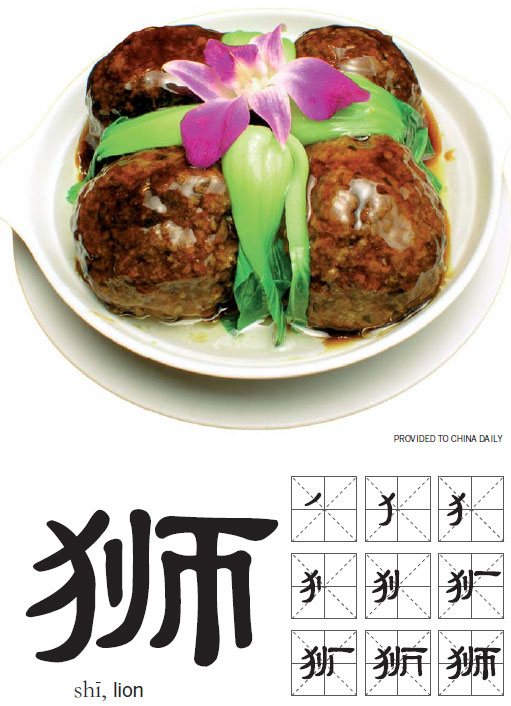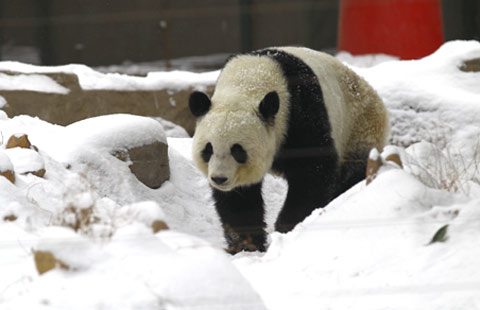The lion's roar
Updated: 2014-02-28 08:45
By Zhu Weijing (China Daily Europe)
|
|||||||||||

Chinese meatballs that bite back 昨日炀帝狮子头,进入寻常百姓家
This Huaiyang gastronomic delight hails from the Yangtze River Delta in Jiangsu province and is a bit more filling than your usual Chinese fare. Soft and juicy, lion's head (狮子头) is the quintessential Chinese meatball. Its lean pork surrounds green vegetables, and, when done right, the aroma is absolutely mouthwatering. Lion's head adheres to the core principles of Chinese cuisine: "色香味俱全", that a truly good dish should "look good, smell good, and taste good".
The lion's head soup is said to originate from Emperor Suiyang (隋炀帝)'s cruise down the legendary Grand Canal. In the city of Yangzhou, officials presented four opulent dishes inspired by four famed local landscapes, following the fashion of the time. There was one dish that impressed the emperor, his concubines and officials alike: sunflower chopped meat (葵花斩肉), inspired by the beautiful scenery in Sunflower Hills. After the emperor left, the dish gradually became a must-have folk dish in the area.
However, the sunflower meat dish did not roar until the next dynasty,, the Tang Dynasty (AD 618-907), renamed at the feast of Wei Zhi (韦陟), the Duke of Huan. Upon seeing the dish, this food connoisseur noticed that with the vegetables resembling a lion's mane, the meat ball is like a lion's head. Wei Zhi thus toasted: "To commemorate today's feast, this dish shall be renamed lion's head." In the Qing Dynasty (1644-1911), the southern dish was brought back to the Imperial Palace during one of the Qianlong (乾隆) Emperor's expeditions south. From a southern staple, lion's head was adapted into the Chinese imperial cuisine.
There are many ways to make the lion's head, but the most popular and the best known is the braised style. The secret to making a perfect lion's head lies in the minced meat, as well as the pot; both determine the dish's juiciness and texture. Some also add crab meat or water chestnuts for variations in flavor. In the Qing Dynasty cookbook Suiyuan Shidan (Recipes from the Garden of Leisure), the author and poet Yuan Mei (袁枚) remarked: "Large as a teacup, the texture was tender and exquisite. The soup was especially light, fresh, and delicious; the meatballs melt in your mouth (大如茶杯,细腻绝伦,汤尤鲜洁,入口如酥).
A classic dish in Chinese cuisine, lion's head migrated and was adapted across China. In the North, it is simply called giant meatball (大肉丸子), or the auspicious meat ball of quadruple happiness (四喜丸子). The story goes that the former premier Zhou Enlai (周恩来) was a lion's head fan, and it was one of his three favorite dishes. The prodigious artist Zhang Daqian (张大千) was also a master at making lion's head. Zhang's tips? Chop the meat to the size of rice grains so that the spaces left in the mixture can lock in the delicious juices.
From the Yangtze River Delta to the emperor's table, these lion's head meatballs have been adapted and changed to suit the tastes of the nation's delicate palate. Today, it can be found almost anywhere; now it is your turn to try to add your own spice to this succulent savory dish.
Recipe | Braised two winters
Ingredients
300g mix of fat and lean pork 五花肉 (wúhuāròu)
20g white radish 白萝卜 (bāiluóbo)
15g scallion, shredded and sliced 葱 (cōng)
10g ginger 姜 (jiāng)
3 tablespoons of yellow wine 黄酒 (huángjiǔ)
4g salt 盐 (yān)
10g sugar 糖 (táng)
6g chicken extract 鸡精 (jījīng)
15g cornstarch 淀粉 (diànfěn)
1 egg 鸡蛋 (jīdàn)
450ml of cooking oil 食用油 (shíyòngyóu)
3 star anises 八角 (bājiǎo)
2 tablespoons of soy sauce 酱油 (jiàngyóu)
4 canolas 油菜 (yóucài)
Method:
1. Cut the meat into small chunks, and then chop the meat into a roughly cut mince.
2. Add the shredded radish, scallion, half the yellow wine, three quarters of the salt, sugar, chicken extract and the egg. Stir until the texture becomes sticky.
3. Add cornstarch and stir until even. Shape the mix into four balls, each about a handful in size.
4. Heat the oil and fry the meatballs on medium heat. Keep them turning until they are golden.
5. In a new wok, add sliced scallion, ginger, anises, yellow wine and soy sauce. Put in the meatballs and enough water to immerse them. Add in salt, sugar and chicken extract. Boil for 15 minutes on medium heat and dish up the meatballs. Mix cornstarch with water and pour the resulting sauce into the wok. Stir well and pour the hot sauce over the meatballs on the plate.
6. Immerse the canola in boiling water for five seconds and take them out. Set them around the meatballs, and the dish is ready to serve.
Courtesy of The World of Chinese, www.theworldofchinese.com
The World of Chinese

(China Daily European Weekly 02/28/2014 page27)
Today's Top News
Ukraine mobilizes after Putin's move
War in Ukraine a long shot, experts say
Beijing-area air better than before
EU condemns China's terrorist attacks
Abe 'shut the door': spokesman
Putin not yet decided on use of force in Ukraine
28 dead in Kunming violence
China, UK hold dialogue on ties
Hot Topics
Lunar probe , China growth forecasts, Emission rules get tougher, China seen through 'colored lens', International board,
Editor's Picks

|

|

|

|

|

|





